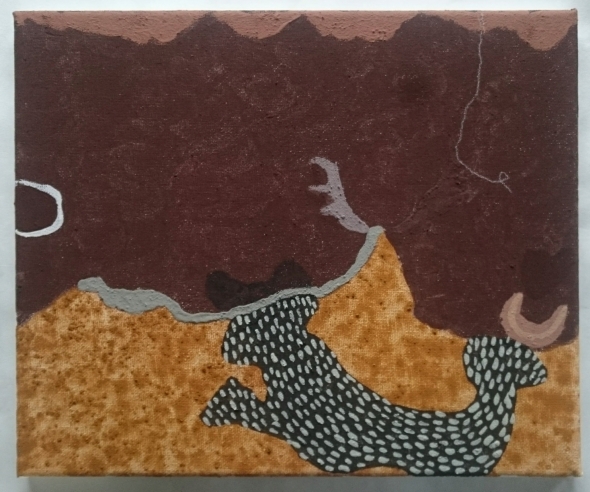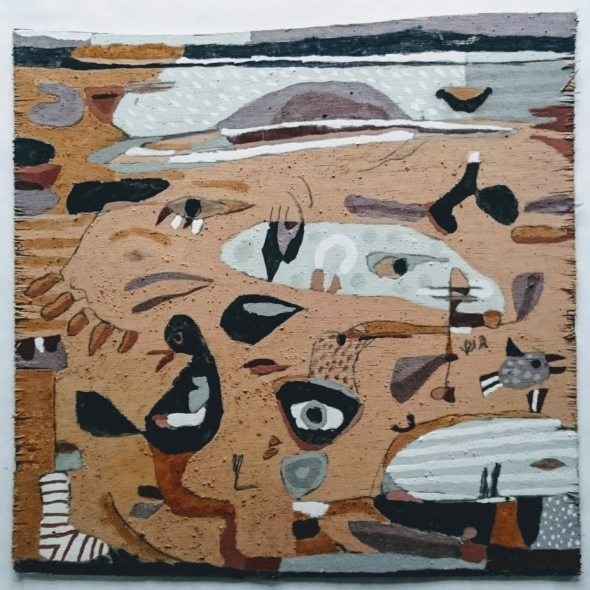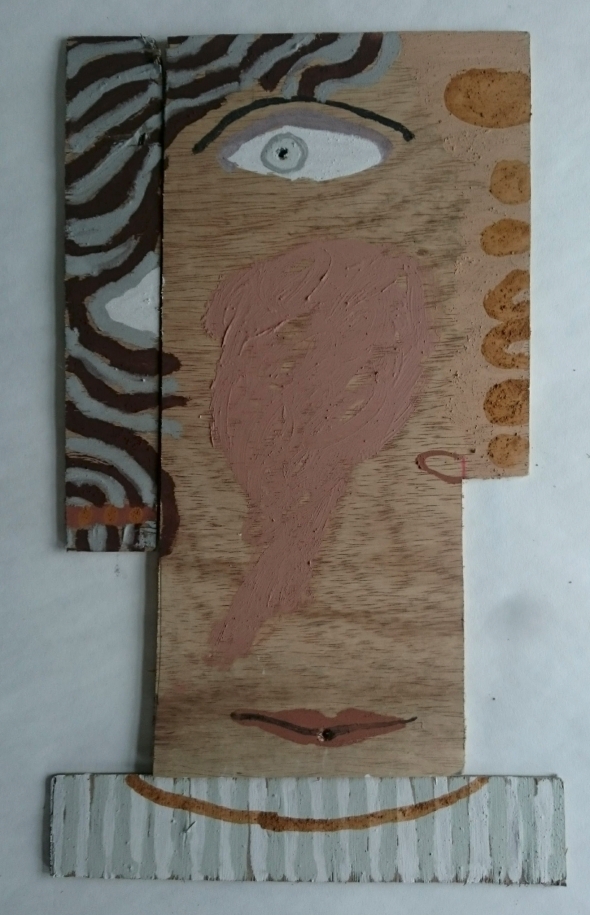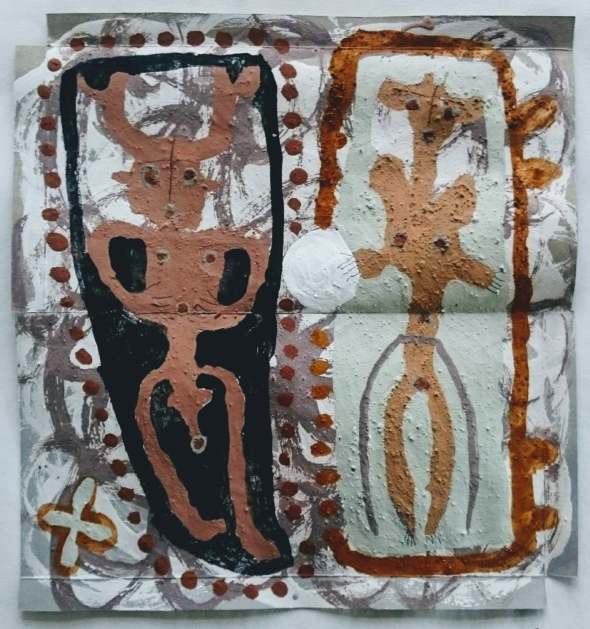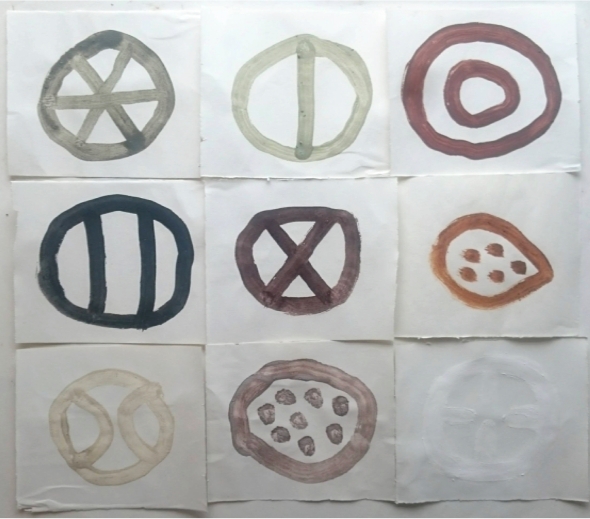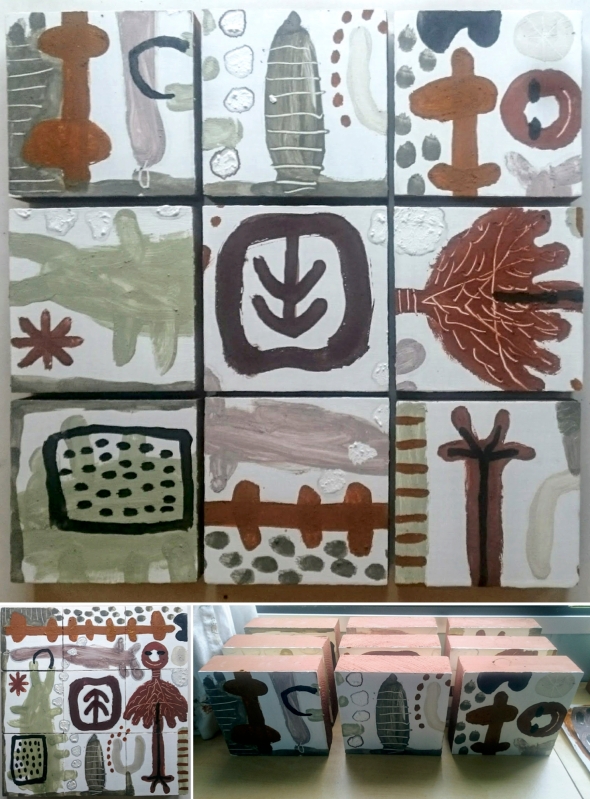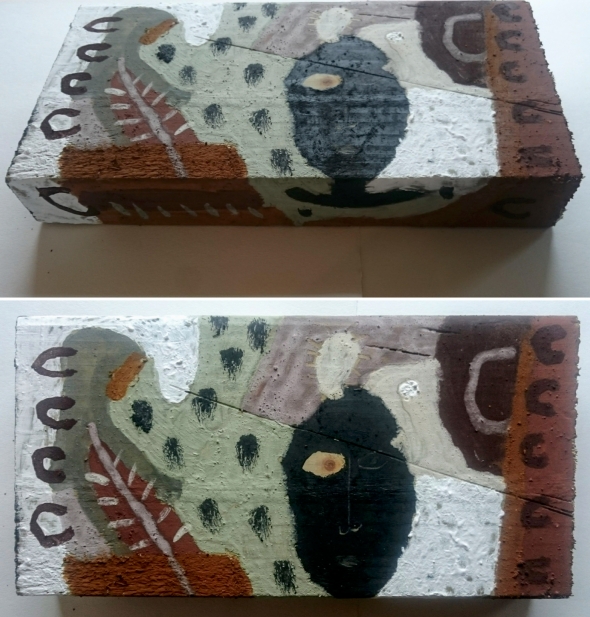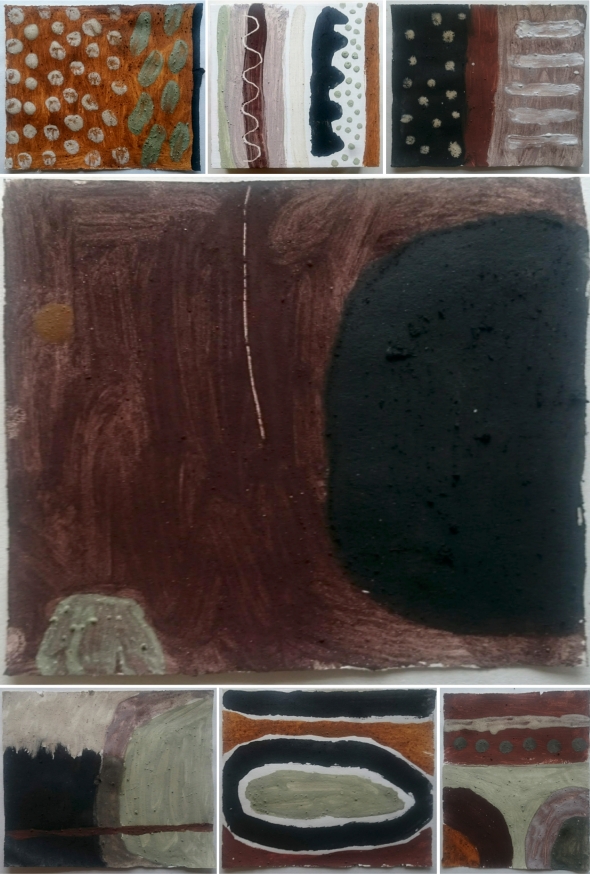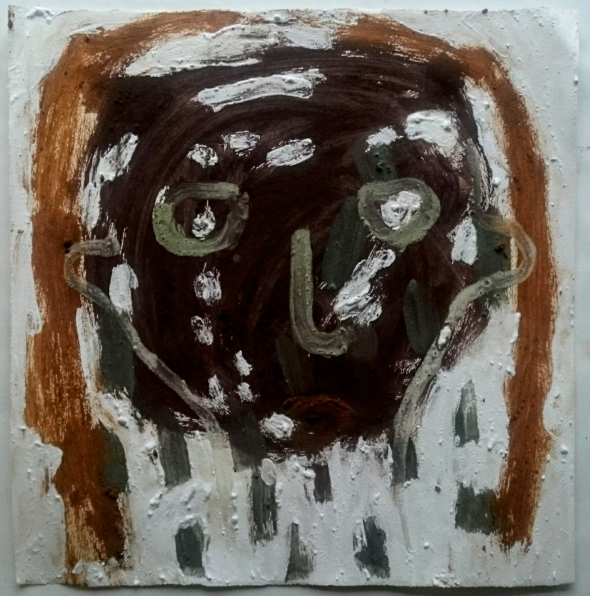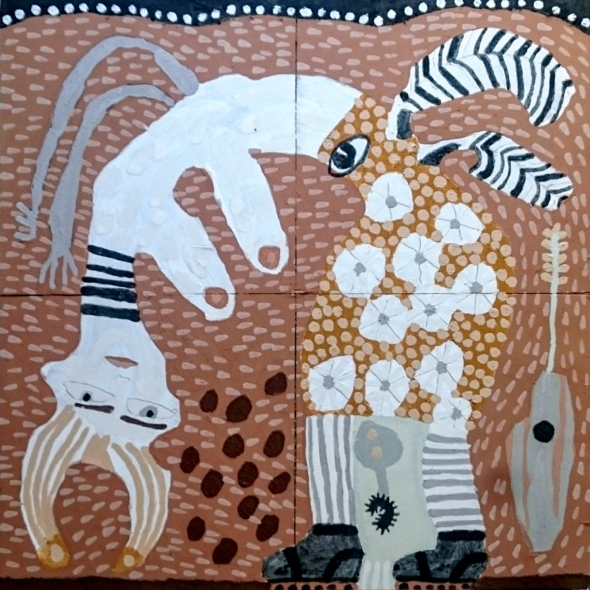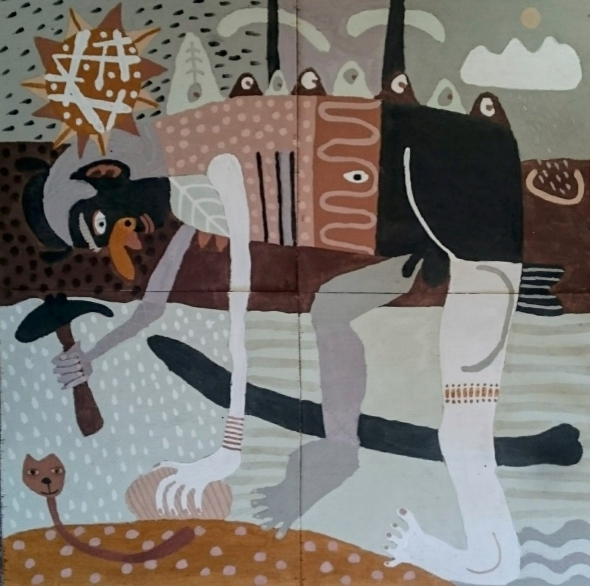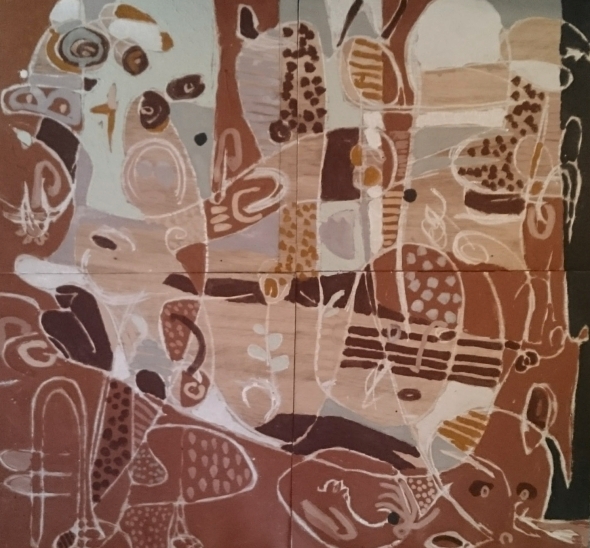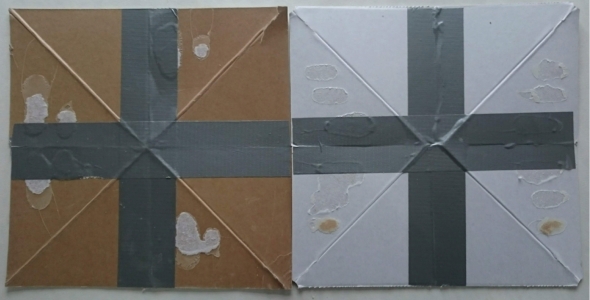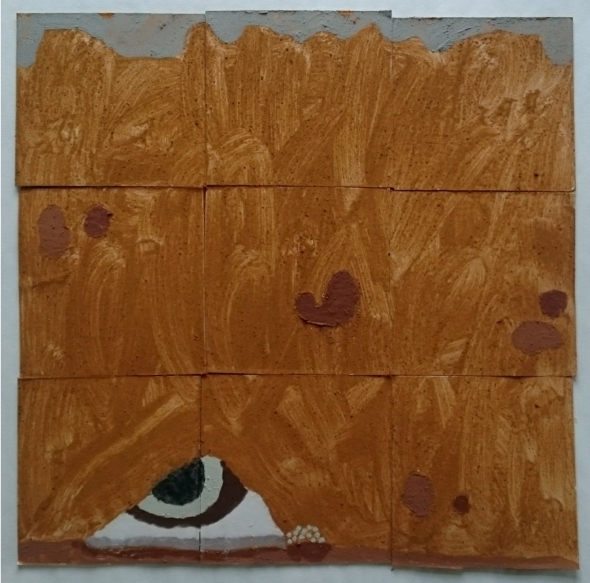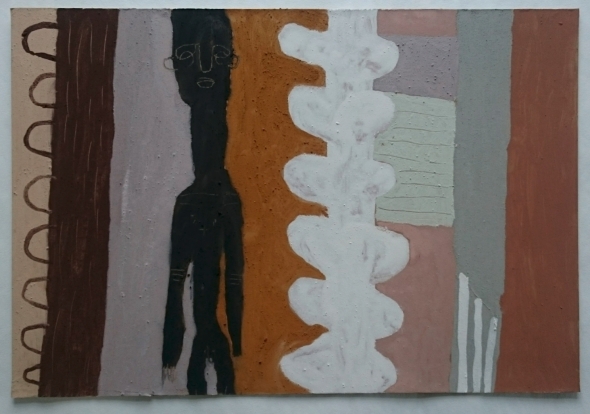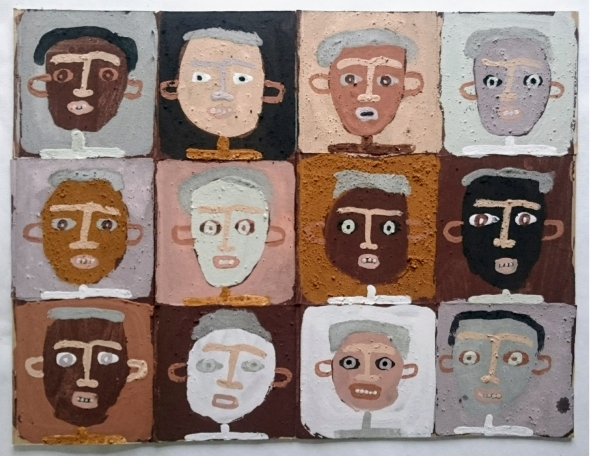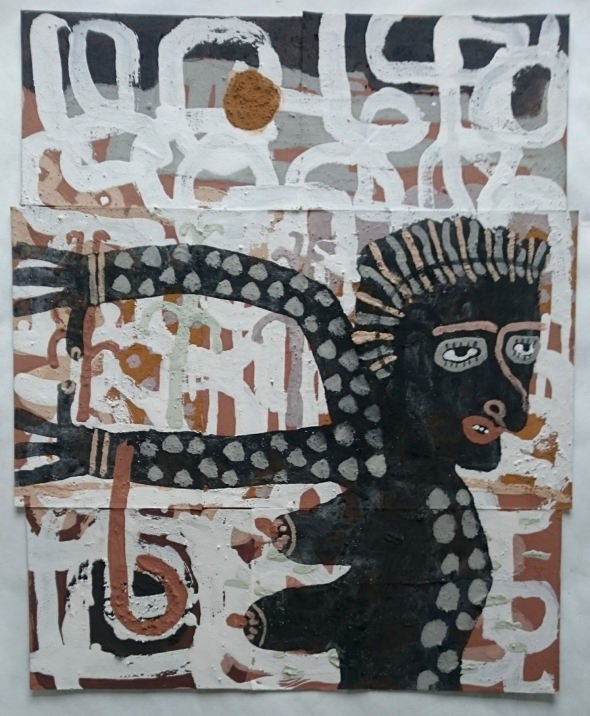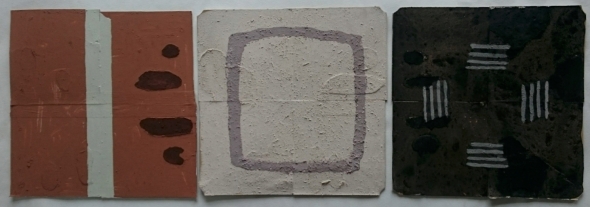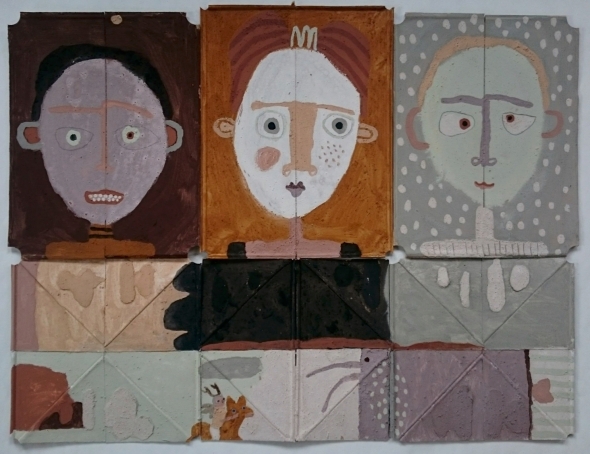with sadness (and in love)
Posted: November 13, 2017 Filed under: the ash tree, Uncategorized | Tags: #GNAP France 2017, Arte Povera, Devon, Ecology, ecopsychology, Meditation, North Devon, poetry, Ritual Leave a comment.
at times of loss and grief
we may turn to Nature for solace,
to water, wind, fire and earth
to rocks, soil, fungi and trees
to insects, animals and birds
.
for guidance
for resilience
and strength
.
we may immerse ourselves
in the mundane, in the everyday
in routine and simplicity
.
not to avoid the pain
but to live with it
to feel it without distraction
.
we may assimilate our feelings and thoughts
through our work
through creative activity
through cathartic acts
through play
.
I sit in the flowing river
the cool water moves around my stationary working form
touching my legs, ankles and hips, hands and forearms,
I feel connected to life
once more
.
or through physical activity
where the rhythm of movement,
of muscles and breath and heart working in time,
lift us to an alternate state
.
to see our situation anew
in a different light
not with mind
but with body
.
and in fantasy and dreams
the world becomes larger
not illusionary but more real
past present future revealed
.
through our actions we may sense
the wonder of each passing moment
of being alive with our pain
of feeling at all
.
and with thanks
we can move forward
and in love
.
 la grille d’entrée, Les Perrières, France © p ward 2017
la grille d’entrée, Les Perrières, France © p ward 2017
 les crânes et les plumes, Les maison troglo de Forges, France © p ward 2017
les crânes et les plumes, Les maison troglo de Forges, France © p ward 2017
 pic vert, les Perrières, France © p ward 2017
pic vert, les Perrières, France © p ward 2017
 graffiti, Ackermann champagne vaults, France © p ward 2017
graffiti, Ackermann champagne vaults, France © p ward 2017
 morning lake, Offwell Woods, Devon © p ward 2017
morning lake, Offwell Woods, Devon © p ward 2017
 pollen path, Coombe Woods, London © p ward 2017
pollen path, Coombe Woods, London © p ward 2017
 blocks, The Lizard, Cornwall © p ward 2017
blocks, The Lizard, Cornwall © p ward 2017
 blue butterfly, Hele, Devon © p ward 2017
blue butterfly, Hele, Devon © p ward 2017
 mine shafts, Penwith, Cornwall © f owen/p ward 2017
mine shafts, Penwith, Cornwall © f owen/p ward 2017
 Portland Place, Ilfracombe, Devon © p ward 2017
Portland Place, Ilfracombe, Devon © p ward 2017
 Croyde Bay, Devon © p ward 2017
Croyde Bay, Devon © p ward 2017
.
© P Ward 2017
in Transit…
Posted: November 5, 2017 Filed under: activ8, Uncategorized | Tags: Arte Povera, Arts, arts research, eco art, ecopsychology, Environmental art, graffiti, North Devon Coast, poetry Leave a commentnew works of a more temporary nature…
.
“Because things are the way they are, things will not stay the way they are.” Bertolt Brecht
.
what does one do when one is in transit, on the move, between stations, so to speak?
just how does one occupy oneself in a meaningful and creative manner when one’s foundations are all asunder, albeit temporarily?
it is a most unsettling situation indeed (quite literally), this moving about, this uprooting and replanting, this altering of, well, almost everything…
.
perceptions
perspectives
.
I am making ready for change
but unwilling to predict or control just how such changes may manifest.
they will more than likely simply emerge quite naturally,
not without a struggle perhaps,
but in an organic way.
.
in the meantime
there is the matter of packing away stuff,
clearing space for the new
both physically and emotionally,
and simply getting rid of that which no longer serves a purpose.
then there is of course the more mundane,
taking advantage of a lull or space to administer and catch up with paperwork and websites etc
and, of course, the constant reflection upon where one has been, where one is now and where one might like to go…
.
the studio, my place of creative refuge for two years is already dismantled
neatly stowed in a safe space, a strange sensation, a sense of detachment from my life vocation.
and yet all this has been done before.
and we adapt,
we make the most of what we have,
we continue to create, to cast our influence in the world
and the new situation inspires newness in all
.
it is rather exciting
this nomadic nuance
.
so here’s to new life
to new possibilities
to uncertain futures
.
isn’t it always this way after all…
.
 walking up Holdstone Down, Exmoor, North Devon © f owen 2017
walking up Holdstone Down, Exmoor, North Devon © f owen 2017
 après les Perrières (boots, sheep dung necklace, ibis feathers, clay model (courtesy Majid Ziaee*), tickets, red valerian sprig, stick and string) © p ward 2017
après les Perrières (boots, sheep dung necklace, ibis feathers, clay model (courtesy Majid Ziaee*), tickets, red valerian sprig, stick and string) © p ward 2017
 flowers and earth, red valerian posy, earth pigments, pestle and mortar © p ward 2017
flowers and earth, red valerian posy, earth pigments, pestle and mortar © p ward 2017
 XO, boots with ball clay and cordyline parcels © p ward 2017
XO, boots with ball clay and cordyline parcels © p ward 2017
 red valerian posy © p ward 2017
red valerian posy © p ward 2017
 walk in Brownsham Woods, Hartland, Devon © p ward 2017
walk in Brownsham Woods, Hartland, Devon © p ward 2017
 tides, offcuts on canvas; we are a break in the waves (my beach) © p ward 2017
tides, offcuts on canvas; we are a break in the waves (my beach) © p ward 2017
 walk at Shirley Heights, London © p ward 2017
walk at Shirley Heights, London © p ward 2017
 woodland graffiti, Shirley Heights, London © p ward 2017
woodland graffiti, Shirley Heights, London © p ward 2017
 les trois galets de Marc Averly; Prince Albert Bridge, River Thames, from Battersea Park, London** © p ward 2017
les trois galets de Marc Averly; Prince Albert Bridge, River Thames, from Battersea Park, London** © p ward 2017
 les trois galets de Marc Averly; Peace Pagoda, Battersea Park, London** © p ward 2017
les trois galets de Marc Averly; Peace Pagoda, Battersea Park, London** © p ward 2017
 les trois galets de Marc Averly; Turbine Hall, Tate Modern, Southbank, London** © p ward 2017
les trois galets de Marc Averly; Turbine Hall, Tate Modern, Southbank, London** © p ward 2017
 OXO – the City from the Southbank, London © p ward 2017
OXO – the City from the Southbank, London © p ward 2017
 pavement arrangement, Shirley, London © p ward 2017
pavement arrangement, Shirley, London © p ward 2017
 les trois galets de Marc Averly; Stonehenge, Salisbury Plain, Wiltshire** © p ward 2017
les trois galets de Marc Averly; Stonehenge, Salisbury Plain, Wiltshire** © p ward 2017
 daisy earth ball; procession; Stonehenge, Wiltshire © p ward 2017
daisy earth ball; procession; Stonehenge, Wiltshire © p ward 2017
 new year sunrise, Hele, North Devon © p ward 2017
new year sunrise, Hele, North Devon © p ward 2017
 no Wales today, from Hillsborough, North Devon © p ward 2017
no Wales today, from Hillsborough, North Devon © p ward 2017
 samhain, Hele (heal), North Devon © p ward 2017
samhain, Hele (heal), North Devon © p ward 2017
 offcut composition, wood © p ward 2017
offcut composition, wood © p ward 2017
 3 is better than 2 (apparently), Lynmouth, North Devon © p ward 2017
3 is better than 2 (apparently), Lynmouth, North Devon © p ward 2017
 brick, Lynmouth North Devon © p ward 2017
brick, Lynmouth North Devon © p ward 2017
 Contisbury Head, from Lynmouth © p ward 2017
Contisbury Head, from Lynmouth © p ward 2017
 driftwood arrangement, Lynmouth, North Devon © p ward 2017
driftwood arrangement, Lynmouth, North Devon © p ward 2017
 finding a temporary equilibrium, Lynmouth, North Devon © p ward 2017
finding a temporary equilibrium, Lynmouth, North Devon © p ward 2017
with many thanks to family and friends, new and old…
© P Ward 2017
* http://www.majidziaee.com/index.php/en/
** Les Trois Galets de Marc Averly is a project by French artist Marc Averly (https://www.facebook.com/marc.averly) . He asks friends to photograph his hand formed wooden ‘galets’ in different places around the world and is compiling a fascinating and entertaining compendium of the images. Much of Marc’s work focuses on wood and trees, and he has a massive knowledge around the subject that he shares at interdisciplinary symposiums and workshops.
real time Sisters
Posted: October 31, 2017 Filed under: eARTh, the ash tree, Uncategorized | Tags: Arte Povera, arts research, Coldharbour Mill, ecopsychology, indigenous culture, poetry, Technology, Visual arts, West Somerset Leave a comment(Samhain) 311017
.
today time returns
and darkness drags us home, amidst swirling russet leaves,
to its familiar solstice resting place
as another year quietly slips away.
.
shadows lengthen
losing their resemblance to matter
and we descend into that underworld
of ancestors and past deities,
.
to industry and wonder,
to miraculous machines
and steam and noise –
hell for some, power for others –
.
weaving what was once made by hand
beneath clear open skies lit by a million stars,
connecting us to all that has been
and will ever be.
and the Sisters still sit
sharing their charms,
weaving mystery and fate
beyond our control or simple understanding.
 tall chimney, Coldharbour Woollen Mill, Uffculme, Devon © p ward 2017
tall chimney, Coldharbour Woollen Mill, Uffculme, Devon © p ward 2017
 engine houses, bobbins and spinning machines , Coldharbour Woollen Mill, Uffculme, Devon © p ward 2017
engine houses, bobbins and spinning machines , Coldharbour Woollen Mill, Uffculme, Devon © p ward 2017
 skein maker, Coldharbour Woollen Mill, Uffculme, Devon © p ward 2017
skein maker, Coldharbour Woollen Mill, Uffculme, Devon © p ward 2017
 threading the loom, Coldharbour Woollen Mill, Uffculme, Devon © p ward 2017
threading the loom, Coldharbour Woollen Mill, Uffculme, Devon © p ward 2017
 water wheel, Coldharbour Woollen Mill, Uffculme, Devon © p ward 2017
water wheel, Coldharbour Woollen Mill, Uffculme, Devon © p ward 2017
Last weekend I visited Dunster, a charming Medieval village in West Somerset with my family. We ‘watched’ stars inside an inflatable dome as part of Exmoor National Park’s Dark Skies program celebrating the unpolluted ‘darkness’ of the area and stayed at my brother’s cottage amongst the massive oaks and rich red soils of the Brendon Hills. On our way home we stopped off at Coldharbour Mill Museum in Uffculme, Devon, for one of their regular ‘Steam Up Days’. This restored working woollen mill is powered by water and steam engines (and electricity) and gives a fascinating insight into the ingenuity and industry involved in the production of wool and woven cloth over the last few centuries when Devon and Exmoor were one of the main centres for the wool trade in Britain. And all this on the days the clocks are turned back to solar time again and the Celtic New year begins – quite a brew for the imagination…
 dunster, west somerset © p ward 2017
dunster, west somerset © p ward 2017
 nettlecombe, west somerset © p ward 2017
nettlecombe, west somerset © p ward 2017
© P Ward 2017
invisible friends
Posted: October 9, 2017 Filed under: activ8, eARTh, the ash tree, Uncategorized | Tags: Arte Povera, arts research, collaboration, ecopsychology, Feeling, poetry Leave a commentmusing upon the muse 91017
.
you warm me
encouraging and invigorating
my muscles, mind and breath
you are so close
yet not here
I long to share a meal, a drink, a show
a long slow walk home
 valerian hapa-zome print © eARTh 2017
valerian hapa-zome print © eARTh 2017
sometimes in life we encounter people
to whom we feel a deep attraction and connection –
a zap between the eyes
an undeniable pull towards,
unwarranted and unthought-of,
an often beautiful but emotionally inconvenient surprise.
 whale shark on my doorstep © p ward 2017
whale shark on my doorstep © p ward 2017
yet circumstances mean our relationships are curtailed
or must take forms different from those we conventionally recognize.
contemporary communications may allow a frustratingly superficial contact,
hand written letters and gifts another, maybe more real,
sometimes even these are not possible
when we honestly crave a wholly physical means –
eye contact and the subtle nuance of body language
the time and space to freely exchange the energetic dynamic
that common interests and diverse histories reveal,
to share a meal, a drink and a long walk home
hands entwined
 dragged through sand, woolacombe bay © p ward 2017
dragged through sand, woolacombe bay © p ward 2017
as an artist, such desire may act as muse:
a light in the darkness, a spark of imagination
exploring the unknown undiscovered spaces,
a chance to meet the familiar through another’s eyes,
or identify and examine new aspects of ourselves –
dreams undreamt , fears as yet unconfronted, renewed aspirations,
detaching oneself from the mundane,
an illusion or delusion
but inspiration all the same;
or fuel to intention
to communicate more wholly
through pathways beyond the visible
 ground earth pigment rings © eARTh 2017
ground earth pigment rings © eARTh 2017
and for those of us who entertain such fantasies about a subtle sense –
who honour a telepathic connection,
like that between a mother and child
or soul-mates
or lovers,
then the distance between may become an ethereal whisper
a breath, a feeling, a warmth, a glow
a longing acceptance of fate
still not manifest
 buoyancy aids and clamped wheel, hele © p ward 2017
buoyancy aids and clamped wheel, hele © p ward 2017
so maybe this is ‘hope’
or merely wishful thinking
a means to find strength and courage in isolation
to believe in another way
in spirit
in love
.
I do
.
(with love and thanks to those who are not here)
© P Ward 2017
Le Mystère des Faluns
Posted: September 29, 2017 Filed under: Uncategorized | Tags: #GNAP France 2017, Arte Povera, ecopsychology, Land Art, poetry Leave a comment.
chemistry
biology
physics
.
geography
geology
and history
.
of a place in time
.
we look we see we touch
we share
we learn
.
breathing just beneath the surface
unseen
but felt
deeply
.
I fall in love
to climb out
again and again and again
© P Ward 2017
Global Nomadic Art Project France 2017
Posted: September 27, 2017 Filed under: A BUNDLE OF STICKS, activ8, eARTh, the ash tree, Uncategorized | Tags: #GNAP France 2017, Arte Povera, Arts, arts research, collaboration, earth pigments, eco art, Ecology, Environmental art, Land Art, painting, Pigment, Visual arts 1 CommentArt Underground
 Residency group photo © GNAP France 2017
Residency group photo © GNAP France 2017
In early September I was fortunate to be among 22 international artists (from as far afield as South Korea, USA, India, New Zealand, Iran, Australia, Germany, Italy and France) warmly invited to Doué en Anjou in the Saumur Region of the Loire, France, to live and work amongst the plethora of caves that sit just beneath the surface. During the 10 day residency we were taken to troglodyte habitations, sarcophagus workshops, a zoo, a farm, a quarry, a woodland lake, art galleries, champagne cellars, vineyards and restaurants as well as sites along the Loire to create site-specific nature-based works. Final installations and video works were presented to an audience of 900 sponsors, local school children, press, dignitaries and the general public at Les Perrieres cave centre as part of the national Heritage celebrations. The residency, part of a series throughout Europe organized by YATOOi during 2017, was a wonderfully rich and playful cultural exchange supported by local generosity and inspiring an outstanding depth and variety of work reflecting the diverse backgrounds and environments shared.
 residency visits and hospitality © GNAP France 2017
residency visits and hospitality © GNAP France 2017
 residency site visits © p ward/GNAP France 2017
residency site visits © p ward/GNAP France 2017
 Magdelene Dolmen, GNAP France © p ward 2017
Magdelene Dolmen, GNAP France © p ward 2017
Despite the difficulties of language good friendships were established through common acts of work and play, through the joyful sharing of cultural peculiarities and through shared experience, all helped by a plentiful supply of local wine and champagne – we were in France after all! The generosity and openness of the local people, businesses and sponsors to a group of unknown artists descending into the area was quite remarkable. All events within the residency – openings, introductions, public presentations and the final exhibition – were all well and enthusiastically attended. Much credit should of course be given to the residency organizers (Olivier Huet and Magrit) who brought such bounty to the group and facilitated the residency in a wonderfully warm, relaxed and friendly manner. As you can see from the program we were kept very busy during the residency adding an enjoyable intensity to proceedings.
 residency program © GNAP France 2017
residency program © GNAP France 2017
 Les Perrieres, cave visitor centre © Sally Kidall 2017
Les Perrieres, cave visitor centre © Sally Kidall 2017
The work, framed within the residency as ‘Nature’ or ‘Land’ Art, was created during short ’workshops’ (visits) to places of interest or relevance to the theme of ‘Art Underground’. It was hoped that through simple introductions to the history, ecology and geology of the places we would build up a sense of the extraordinary dual (underground/surface) character of the region. Throughout the first week we all developed a better relationship to and sense of the materials prevalent and formative to the area. This knowledge allowed us to slowly form ideas for a final piece to be installed or shown within or near the cave complex at Les Perrieres where we were so comfortably accommodated. The cave complex is a fantastic attraction in itself, catering for public and school groups, having employed artists to interpret and enrich the network of caves carved from the earth for building materials over the last 500 years. The experience of spending such a lot of time underground, to emerge intermittently into the ‘light’, was at once quite disorientating and somehow reassuring, and also hard to describe. (Returning home to a small house in the English countryside, with windows overlooking a valley, certainly felt very strange.)
 Seven Bodies, GNAP France © Atefah Khas 2017
Seven Bodies, GNAP France © Atefah Khas 2017
 peter ward, GNAP France workshop installations © p ward 2017
peter ward, GNAP France workshop installations © p ward 2017
As an artist (maybe overly) academically acquainted with the various forms and history of environmental art it was fantastically refreshing to simply make – to spend time with others in an environment, to explore new and familiar materials in a different context and to enjoy the varied processes employed by the other artists. The care and attention both in making, recording and documenting that was adopted by many was an inspiration. An amazing skill for choosing sites for installations where they may be viewed and documented best was also apparent, as was an enviable dexterity with digital editing and animation among the group.
 ombre, GNAP France © Valeria Codara 2017
ombre, GNAP France © Valeria Codara 2017
 Marc Avery, Majid Ziaee, Donald Buglass, Valeria Codara, Joël Thépault © GNAP France/Joël Thépault 2017
Marc Avery, Majid Ziaee, Donald Buglass, Valeria Codara, Joël Thépault © GNAP France/Joël Thépault 2017
 Pierre Guilloteau, Joël Thépault, Isabelle Aubry, Roger Rigorth © GNAP France 2017
Pierre Guilloteau, Joël Thépault, Isabelle Aubry, Roger Rigorth © GNAP France 2017
 Essentials Atefeh Khas/Roger Rigorth, Joël Thépault © Atefeh Khas/Roger Rigorth/Joël Thépault/GNAP France 2017
Essentials Atefeh Khas/Roger Rigorth, Joël Thépault © Atefeh Khas/Roger Rigorth/Joël Thépault/GNAP France 2017
 Gunjan Tyagi (and friends) © GNAP France 2017
Gunjan Tyagi (and friends) © GNAP France 2017
 Sally Kidall/Cherie Sampson, Pascale Planche, Soon-im Kim, Lee Sun-ju, Aarti Zaveri © GNAP France 2017
Sally Kidall/Cherie Sampson, Pascale Planche, Soon-im Kim, Lee Sun-ju, Aarti Zaveri © GNAP France 2017
 Ahmad Nadalian, Roger Rigorth, Pascale Planche, Patrick Tagoe-Turkson, Gunjan Tyagi, Ute Ritschel © GNAP France 2017
Ahmad Nadalian, Roger Rigorth, Pascale Planche, Patrick Tagoe-Turkson, Gunjan Tyagi, Ute Ritschel © GNAP France 2017
 Public Presentations, Philippe Noiret Theater of Doué-en-Anjou © GNAP France 2017
Public Presentations, Philippe Noiret Theater of Doué-en-Anjou © GNAP France 2017
 martyr, objets trouvé, © p ward 2017
martyr, objets trouvé, © p ward 2017
The lack of academic analysis and critique, whether by design or through language difficulties, was simply refreshing. While Land Art or Nature Art may be acknowledged within an art historical context it is often totally dismissed (for which I have been guilty) as a relevant form or practice by more ecologically/socially engaged contemporary artists. For example, Richard Long is often criticized for simply taking formal and conceptual ideas out of the gallery or bringing ‘natural’ materials back in, while Andy Goldsworthy overly-aestheticizing Nature, without acknowledgement of any political issues relevant to subject, material or space, and Robert Smithson for the use of massively macho machinery to make vast changes to a landscape without consideration for ecological consequences. I now personally appreciate all as parallel and historical aspects to all work of and about the environment – Art does not always have to be so overtly political after all, working intrinsically and subliminally within culture as a whole.
 oP77, earth pigments, GNAP France © p ward 2017
oP77, earth pigments, GNAP France © p ward 2017
The experience of GNAP France has given me a fresh perspective on my own prejudices, reiterating the value of personal tactile experience and expression within an environment, offering the opportunity to celebrate and share aspects of nature that may often go unobserved on both a minute and architectural scale, as well as space to develop a deeper sense of oneself within Nature. It is all a learning process. The residency offered such a space to the artists with little pressure to produce but simply to participate – to make contacts, to observe and to share within an international setting: something many of us seldom have the chance to enjoy. In the words of Italian artist, Valeria Codara, “It is only when we open ourselves to others that new ideas can emerge” (one of the few political sentiments expressed towards any of the work during the residency). Whether the individual works had ‘value’ in a social or ecological sense beyond the artists’ experience is always debatable, but it cannot be denied that the creation and participation in the whole experience was a rich and deeply transformative process.
 portant un paquet de bâtons sur les bords de la Loire, GNAP France © peter ward 2017
portant un paquet de bâtons sur les bords de la Loire, GNAP France © peter ward 2017
 peinture d’arbres, GNAP France © peter ward 2017
peinture d’arbres, GNAP France © peter ward 2017
The group of artists came from quite different creative backgrounds, culturally and professionally. We were also at various stages in our careers, the GNAP France residency offering differing possibilities for each of us. International networking, including the chance to really meet people we were otherwise only aware of online, was a key element as well as an international flavour to add to our profiles. Work-wise, while many of us approached each site afresh, many brought signature themes and forms to their responses. French artist Pierre Guilloteau brought along his deconstructed ‘wooden ball’ to reconstruct at various sites to great affect as part of his ongoing Longitude 0° project. Others created simple animations or filmed and produced performance pieces – quite a feat in such short periods of time. Some work was monumental in scale some definitely quite ethereal. Some worked with others, some alone. Thankfully there was a fair share of humour too.
 presse à la terre; bétail grotte, GNAP France © peter ward 2017
presse à la terre; bétail grotte, GNAP France © peter ward 2017
Despite a renewed appreciation of the craft, delicacy and aesthetic appeal of some of the more ethereal sculptural pieces my own work remained closely linked to a sense of our contemporary global situation. I certainly played within the aesthetics of unfamiliar materials but feel my stronger works expressed Nature not as a pristine, balanced, elemental world but as a turbulent shifting ecology within which humankind plays an often provocative and sometimes frivolous role (if we are willing to get the joke!?). During the week I began to recognize patterns emerging in my practice. Ways in which I become attuned to a landscape, such as gathering sticks or forming balls from soil, from which the work would develop. There was often a sense of ritual to my process, acknowledging elemental forces within each installation. There was a sense of passing to the final pieces, suggestions of something that had happened to which others were witness, often tinged with sadness and destitution, sometimes with joy. I started to understand the importance of narrative within my work (thank you Sally).
 perdant un jeu, objets trouvé, GNAP France © peter ward 2017
perdant un jeu, objets trouvé, GNAP France © peter ward 2017
For my own final piece, en passant par (passing through), I secured a large cave between two quarries. I was personally drawn to the combination of contemporary objects, surfaces and detritus as well as an abundance of usable natural materials in the space. My intention was to create an immersive experience using pigments, objects, imagery and ideas I had gathered throughout the residency. As an artist working with natural materials and pigments I am often forced to question or recognize the connection between cave art and graffiti. The space and residency offered an excellent opportunity to explore this more fully. I hoped to create a sense of the ‘artist’ passing through, a ‘nomad’, using the cave as a temporary habitation and workspace. Also to highlight the imaginative possibilities of the shapes, textures and structures already evident in the space through a minimal intervention of mark-making and objects. For me it was the largest and most ambitious project I have attempted to date. Thankfully it was well received by fellow artists and the public.
 en passant par, cave installation (detail), objets trouvé and earth pigments, GNAP France © peter ward 2017
en passant par, cave installation (detail), objets trouvé and earth pigments, GNAP France © peter ward 2017
 en passant par, cave installation (detail), objets trouvé and earth pigments, GNAP France © peter ward 2017
en passant par, cave installation (detail), objets trouvé and earth pigments, GNAP France © peter ward 2017 en passant par, cave installation (detail), objets trouvé and earth pigments, GNAP France © peter ward 2017
en passant par, cave installation (detail), objets trouvé and earth pigments, GNAP France © peter ward 2017
GNAP France is certainly an event I will never forget: as a time of learning, living and working on many new levels and having loads of fun with some beautiful new friends, rejuvenating my confidence, ambition and motivation as an artist. I can only thank all those involved – artists, organizers and sponsors – for their generosity in creating such an incredible encounter.
Thank you all for welcoming me so wholeheartedly to the GNAP family.
© P Ward 2017
__________________________________________________________________
GNAP France 2017 was curated by Olivier Huet (association Cranberry) www.gnap-france.fr
List of artists: Isabelle Aubry (France), Marc Averly (France), Claudette Besnard (France), Donald Buglass (New Zealand), Karin Chopin (France), Valeria Codara (Italy), Pierre Guilloteau (France), Atefeh Khas (Iran), Sally Kidall (Australia), Kim Soon-im (South Korea), Lee Sun-ju (South Korea), Ahmad Nadalian (Iran), Pascale Planche (France), Joël Thépault (France), Roger Rigorth (Germany), Ute Ritschel (Germany), Cherie Sampson (USA), Patrick Tagoe-Turkson (Ghana), Gunjan Tyagi (India), Peter Ward (UK), Aarti Zaveri (India), Majid Ziaee (Iran).
sponsors, GNAP France 2017
(Images are from my own collection or made available to me by request or through Yatoo Gnab Facebook pages. All images and works retain copyright to the artist and Yatoo GNAP. I hope I have mentioned everybody? Apologies for so many pictures of my work but hey!…:-))
painting in croatia, june 2017
Posted: August 2, 2017 Filed under: A BUNDLE OF STICKS, activ8, eARTh, the ash tree, Uncategorized | Tags: Arte Povera, Arts, arts research, Croatia, Dugi Otok, earth pigments, ecopsychology, Environmental art, indigenous culture, painting, Pigment, Visual arts 1 CommentOn a recent visit to the ‘long island’ of Dugi Otok on the Adriatic coast of Croatia I was taken by the unfamiliar marks of paint daubed on walls and buildings. Not graffiti as such or even nonsensical paintbrush cleansing ablutions but intentional spots and splashes of household paint. We thought they were maybe way markers or boundary signs. Whatever their purpose I enjoyed how they honed my vision both to the unfamiliar in such a rich but alien culture and also to another sense of painting in and of the environment. rocks and soil I + II, framed; dugi otok, croatia © p ward 2017
rocks and soil I + II, framed; dugi otok, croatia © p ward 2017
 dockside paintings; sali, croatia © p ward 2017
dockside paintings; sali, croatia © p ward 2017
Wherever we travel it is the unfamiliar colours, patterns, shapes, sounds, smells, tastes and materials that inspire and refresh our imaginations and remind us of the richness, diversity and potential of this planet that we share while also refreshing the ‘familiar’ in our own backyards. It only leaves us, as creative people, to show our gratuitude through sharing our vision and inspiration with others, hopefully continuing the cycle.
 paint daubs; sali, croatia © p ward 2017
paint daubs; sali, croatia © p ward 2017
 le citron de provence (Gonepteryx cleopatra) butterfly wings; dugi otok, croatia © p ward 2017
le citron de provence (Gonepteryx cleopatra) butterfly wings; dugi otok, croatia © p ward 2017
 ant highway, roadkill toad, pink flowers, white admiral; sali, dugi otok, croatia © p ward 2017
ant highway, roadkill toad, pink flowers, white admiral; sali, dugi otok, croatia © p ward 2017
 festival procession flowers; sali, croatia © p ward 2017
festival procession flowers; sali, croatia © p ward 2017
 a boat and three doorways; sali, dugi otok, croatia @ p ward 2017
a boat and three doorways; sali, dugi otok, croatia @ p ward 2017
 confectionery constellation, casual installation, pink house; sali, croatia © p ward 2017
confectionery constellation, casual installation, pink house; sali, croatia © p ward 2017
 handprints and paint; sali, croatia © p ward 2017
handprints and paint; sali, croatia © p ward 2017
 urban sights I, II + III; sali, croatia © p ward 2017
urban sights I, II + III; sali, croatia © p ward 2017
 pigment and paint I + II; sali, croatia © p ward 2017
pigment and paint I + II; sali, croatia © p ward 2017
 playground moths; sali, croatia © p ward 2017
playground moths; sali, croatia © p ward 2017
 four colours; dugi otok, croatia © p ward 2017
four colours; dugi otok, croatia © p ward 2017
 sticks and stones; dugi otok, croatia © p ward 2017
sticks and stones; dugi otok, croatia © p ward 2017
 unfamiliar shrub; sali, croatia © p ward 2017
unfamiliar shrub; sali, croatia © p ward 2017
 red and yellow makes orange, walls; sali, croatia © p ward 2017
red and yellow makes orange, walls; sali, croatia © p ward 2017
 nature park telašćica, dugi otok, croatia © p ward 2017
nature park telašćica, dugi otok, croatia © p ward 2017
 flying; dugi otok, croatia © p ward 2017
flying; dugi otok, croatia © p ward 2017
With thanks to the people, animals, plants and places of Croatia for a most inspiring experience and to Francesca, Noah and Agnes for sharing it with me.
© P Ward 2017
please accept my resignation 131016
Posted: October 13, 2016 Filed under: activ8, eARTh, educ8, Uncategorized | Tags: Aesthetics, Arte Povera, arts research, Bideford Black, child art, collaboration, Communication, cycling, dance, Devon, Earth, earth pigments, eco art, Ecology, ecopsychology, Environmental art, Feeling, Interdisciplinarity, Nature, North Devon, North Devon Coast, Pigment, Visual arts 4 Comments
some things I have seen, done and made that have made me think, feel and smile over the last few months…
“Reading true literature [Nan Shepherd] reflected, ‘it’s as though you are standing experiencing and suddenly the work is there, bursting out of its own ripeness . . . life has exploded, sticky and rich and smelling oh so good. And . . . that makes the ordinary world magical – that reverberates/illuminates.’ ” taken from Landmarks by Robert Macfarlane.
 folded paper; little family; special gifts; friendship (earth pigments on canvas) © p ward 2016
folded paper; little family; special gifts; friendship (earth pigments on canvas) © p ward 2016
 wooden tray full of found things © eARTh 2016
wooden tray full of found things © eARTh 2016
 ‘the exmoor beast’!?, exmoor zoological gardens © p ward 2016
‘the exmoor beast’!?, exmoor zoological gardens © p ward 2016
 drawing a line, coast to coast with skedge 13916 © eARTh 2016
drawing a line, coast to coast with skedge 13916 © eARTh 2016
 learning to draw I © p ward 2016
learning to draw I © p ward 2016
 learning to draw II, III, IV © eARTh 2016
learning to draw II, III, IV © eARTh 2016
 towan beach, roseland peninsula; bottallack mines, st just, cornwall © p ward 2016
towan beach, roseland peninsula; bottallack mines, st just, cornwall © p ward 2016
 west somerset railway; bicclescombe park shed, ilfracombe © eARTh 2016
west somerset railway; bicclescombe park shed, ilfracombe © eARTh 2016
 painted palette (earth pigments on wood) © eARTh 2016
painted palette (earth pigments on wood) © eARTh 2016
 offcuts in an offcut frame – palette; mask (earth pigments on wood) © p ward 2016
offcuts in an offcut frame – palette; mask (earth pigments on wood) © p ward 2016
 figure; offcuts in an offcut frame – VIII (earth pigments on wood); building blocks © p ward 2016
figure; offcuts in an offcut frame – VIII (earth pigments on wood); building blocks © p ward 2016
with special thanks to francesca, noah, agnes, family and friends for your love, support and companionship 🙂
© p ward/eARTh 2016
home: research, research and inspiration – early 2016 update
Posted: June 15, 2016 Filed under: A BUNDLE OF STICKS, activ8, BIOSPHERic, eARTh, Uncategorized | Tags: art and science, Arte Povera, arts research, collaboration, Devon, Earth, earth pigments, East Devon, eco art, Ecology, ecopsychology, Environmental art, Feeling, indigenous culture, Interdisciplinarity, North Devon, North Devon Coast, Pigment, poetry, Soil Culture 2 Commentswater, air and earth
sticks and stones
and, somewhere, fire
.
as the year unfolds
to a new life
within us
.
and you grow
and hold us rapt
in your emphatic personality
.
we deliberate upon Nature
each delicate
and deafening response
.
there is red and black and grey and green
dirt to some
riches to others
.
grinding away
what is left
to leave
.
more
and more
and more
.
we play
and learn
we play together
.
knees
teeth
home
.
 home: County Clare, Ireland © p ward 2016
home: County Clare, Ireland © p ward 2016
The year began with family and friends in a rainswept County Clare, Ireland, my home for 10 years. Many of the places I wanted to revisit and share were beneath meters of water. Things, of course, had changed for better and worse but the spirit of the land still shone through.
 home: Lake Vyrnwy, Powys, Wales © p ward 2106
home: Lake Vyrnwy, Powys, Wales © p ward 2106
Then more mountains and lakes, family and friends, as my brother’s path shifts to the Welsh borders, an area I have not visited before but will visit again. This time snow, ice, fog and sunshine accompanied my journey. Lake Vyrnwy reservoir submerged a Welsh village to supply England with water.
 home: Ilfracombe, winter 2016 © p ward 2016
home: Ilfracombe, winter 2016 © p ward 2016
And at ‘home’ the winter lashes the coastline, reshaping and reforming. Ilfracombe was originally named after King Alfred and was gifted to two of his sons as a sheltered harbour on the western approaches to his kingdom. Before then an iron-age hill fort overlooked the natural harbour from, what is now, Hillsborough nature reserve. This part of the North Devon coast is formed predominantly from Devonian slates, sandstones and shales and boasts some of the highest sea cliffs in England. We have a new studio here that we hope will provide a base for our creative endeavours and space for others to enjoy.
 home: Barnstaple Bay and Hele, North Devon © p ward 2016
home: Barnstaple Bay and Hele, North Devon © p ward 2016
 home: Holdstone Down, Combe Martin, North Devon © p ward 2016
home: Holdstone Down, Combe Martin, North Devon © p ward 2016
 let’s talk dirt! (White Moose Gallery, CCANW, Heritage Lottery Fund, Bideford Pottery, IGI Ltd, Roger Cockram)
let’s talk dirt! (White Moose Gallery, CCANW, Heritage Lottery Fund, Bideford Pottery, IGI Ltd, Roger Cockram)
In May, as part of the CCANW Soil Culture project, I led a walk and talk with the White Moose Gallery and supported by the Heritage Lottery Fund, to celebrate North Devon’s relationship with its earth resources. “Let’s Walk and Talk Dirt!” involved local potters, Harry Juniper and Roger Cockram, geologists Chris Cornford and Andrew Green, and soil scientist David Hogan to present some different perspectives about our local resources. Participants really enjoyed the interdisciplinary nature of the events but were frustrated by the lack of time to explore the subject matter in more depth. We are now working towards a ‘summer school’ to further explore North Devon’s potteries, pigments, rocks and soils.
 Sidmouth, East Devon © p ward 2106
Sidmouth, East Devon © p ward 2106
 Jacob’s Ladder beach, Sidmouth, East Devon © p ward 2016
Jacob’s Ladder beach, Sidmouth, East Devon © p ward 2016
The Thelma Hulbert Gallery, Honiton, East Devon invited me in May, to run painting with earth workshops to accompany their ongoing Soil Culture exhibitions. The first workshop introduced the ideas to a small group of partially sighted children from the WESC Foundation, providing a space for us to enjoy the more than visual experience of the process and materials. I was also excited to be exploring a new area of the country, encouraging me to find new pigments and learn about their geology and history. The second workshop, for artists, included an invigorating morning field trip to Jacob’s Ladder beach in Sidmouth to gather small quantities of the iron-rich red and green mudstones, and whatever else took our fancy, followed by an afternoon of furious experimentation grinding and binding a selection of pigments with a variety of mediums. It was great to meet some new faces in such a lively and friendly gallery.
 home: Wessex – Branscombe beach, East Devon; Hardy country (chalk and flint) © p ward 2016
home: Wessex – Branscombe beach, East Devon; Hardy country (chalk and flint) © p ward 2016
Something that did surprise me was the presence of chalk in the landscape of East Devon. Having been raised in Portsmouth I am familiar with the chalk and flint of the South Downs and Isle of Wight but wasn’t aware of it so far west along the coast. The sedimentary Cretaceous beds at Beer, that I saw from Branscombe beach during a day of research, lie above Upper Greensand that then rests on the more familiar Mercian Triassic red mudstones of South Devon. Apparently there is an ‘unconformity’ here in that the interceding Jurassic layer is missing, the area being land during that era. The nodules of flint and chert present in the Chalk and Upper Greensand that make up the beaches are also apparent in the local architecture creating further similarities to the South Downs and other Chalk areas across Europe.
One such region, that I also feel an affinity with through my ancestry and boyhood cycling adventures, is the Wessex Downs. The ancient country of Wessex encompassed Hampshire, west to the Cornish borders, and Wiltshire, Dorset, Devon and Somerset. In more recent times its character and characters have formed the backdrop for the literary works of Thomas Hardy. I was recently contacted by a research fellow from Exeter University to collaborate in a project to explore the value to health and well being of arts-based environmental workshops. His previous research looked at the work of Thomas Hardy in relation to the Wessex landscape. We are now waiting to see if our initial funding application has been successful before embarking on a major AHRC project around a similar theme. It has been fascinating working with a complete stranger towards a shared goal.
 Hele community group sculpture proposal sketches © eARTh 2016
Hele community group sculpture proposal sketches © eARTh 2016
Meanwhile, closer to home again we have been working with the local community towards re-landscaping an unsightly patch of ground behind the bus shelter in our village. It was good to be invited, to meet some more of our neighbours, to learn about the history of the village and to think how to we might alter such a space to celebrate the area. It was recently discovered that the area is owned (rather than it being public space) which has put the project back somewhat!?
 sketches in wood and stone © p ward 2016
sketches in wood and stone © p ward 2016
And back in the studio I have been enjoying putting together some new work (see previous post) using old offcuts of wood, old pots of paint and some new pigments. After 9 months I finally feel like I am settling in, enjoying the space and making something new, as well as finding time for my other interests and beautiful family. With a new arrival imminent we’ll be working hard to keep it up…
 jacob’s ladder, earth pigments on canvas © p ward 2016
jacob’s ladder, earth pigments on canvas © p ward 2016
 corn mill close, masonry paint on painted board © p ward 2016
corn mill close, masonry paint on painted board © p ward 2016
 offcuts – sketch in wood © p ward 2016
offcuts – sketch in wood © p ward 2016
© P Ward 2016

